6 Leaders Share Their Insights on Diversity, Equity, and Inclusion

In this article, we interview six leaders from various industries to hear their thoughts on how to create a more inclusive workplace culture through DE&I bestpractices.
Introduction
Creating a diverse and inclusive workplace culture is critical to the success of any organization. However, many companies struggle to move beyond the basics of diversity and implement more advanced strategies for fostering inclusivity and equity.
That’s where DE&I (Diversity, Equity, and Inclusion) experts come in. These professionals have dedicated their careers to understanding the complexities of workplace diversity and providing effective solutions for building a more inclusive culture.
In this article, we’ll dive into advanced DE&I strategies and insights from experts in the field.
We’ll explore why traditional diversity programs often fall short, and how organizations can shift their approach to create a more holistic, intersectional approach to workplace inclusion. From unconscious bias training to creating employee resource groups and fostering allyship, we’ll provide practical, actionable tips for organizations looking to take their DE&I efforts to the next level.
By implementing these advanced strategies, companies can create a more equitable, inclusive culture that empowers employees of all backgrounds to thrive and contribute to the organization’s success.
What are some key elements that are necessary to create a safe and inclusive work environment?
Embarking on the quest for a safe and thriving workplace, one must rely on the Six Cs to guide the way: Courage, Commitment, Collaboration, Cultural Intelligence, Curiosity, and Cognizance of Bias. In order to fully secure this haven of creativity and collaboration, three additional fundamental elements are required: Crystal Clear Communication, uncompromising anti-discrimination practices, and authentic leadership accountability. To maintain open lines of communication, employees need reliable avenues to voice their thoughts, share concerns, and offer valuable feedback. This virtuous cycle of communication can be cultivated through various methods, such as team meetings, suggestion boxes, town-halls, and innovative communication channels. Achieving and maintaining this environment is no small feat but is undoubtedly necessary for any truly successful organization. Fostering a workplace environment where discrimination and harassment are met with zero tolerance paves the way for employees to confidently report incidents and misconduct, free from the dread of reprisals. At the heart of this endeavor lies accountable leadership. The commitment of leaders across the organizational hierarchy to cultivating a secure and inclusive atmosphere is crucial, as employees will naturally follow the example set by their trailblazers.
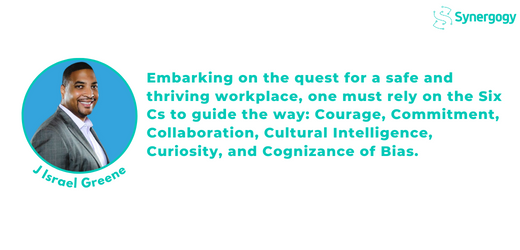
Organisations today are focused on fostering an inclusive and safe workplace environment, where everyone can feel a sense of belonging. This notion of safety and inclusiveness provides an environment for people to bring their best selves to work and thrive, contributing to foundations in workplaces harbored with systemic structures and processes anchored with an equity lens.
An imperative to create an inclusive environment is psychological safety and inclusive leadership excellence, which provides outcomes of deep resonance of belonging and a sense of personal value. Psychological safety and inclusion are not mutually exclusive, in practice they reinforce the other.
Research from Amy Edmundson ( Fearless organisation) and Timothy R Clark ( 4 Stages of Psychological Safety) has proven one of the critical components to successfully increasing psychological safety is leadership advocacy and leader led dialogues. When organisations go through change and transformation if expectations are not transpired with candor; transversally ambiguity, anxiety and apathy amongst people increases. To foster inclusiveness and engagement, leadership advocacy is imperative to intentionally bring psychological safety to the forefront of ways of working, behavior and narrative.
Driven to create outcomes of a safe and inclusive workplace, here are few functions of psychological safety and inclusive excellence garnered to create an ecosystem for people to feel belonging, valued and reach their unique potential –
1. Instill Inclusion safety – create shared meaning by emphasizing a compelling purpose. As a leader contribute openly, articulate non negotiables in teaming tenets and strive to destigmatize failure
2. Embed learners safety – advocate a growth mindset where people can ask better questions, learn from mistakes and be empowered to explore opportunities
3. Activate collaborators safety – have candid dialogues with authenticity and vulnerability. Debate constructively to generate healthy conflict and systematically elicit ideas and concerns.
4. Advocate challengers safety – Model behavioral safety and sanction clear teaming principles; for people to feel safe and challenge the status quo, expose risks and identify changes to support the organisations efforts to go from ‘good to great’.

How can an organisation ensure that all employees feel valued and included in the workplace?
There are so many ways an organisation can make employees feel valued and recognised and that their voice is heard and what they do matters. Many of these don’t require large budgets but a growth mindset and a change of behavior at every level.
1. Companies should have a visible mission statement to support Diversity, Equity and Inclusion acknowledging their commitment to respecting every individual team member.
2. Leaders should be role models and hold themselves accountable for their company culture.
3. They should treat everyone as whole people with lives outside the workplace which can and do impact them professionally.
4. They should demonstrate empathy and compassion to encourage constructive communication which fosters an atmosphere of psychological security. This means that employees will feel comfortable expressing their concerns, opinions, and ideas without fear of retaliation, judgement, or reprisals.
5. Offer multiple ways to make contributions and always give credit and recognition where it is due.
6. Practise active listening and treat all individuals with respect and dignity asking questions before speaking.
7. Express gratitude and reward effort fairly, without playing favourites.
8. Give actionable feedback to all employees not just a select few, with opportunities to learn and grow whether within the context a formal performance appraisal system or an opportunity for promotion.
9. Champion and respect the sharing of cultural traditions and experiences to create an inclusive work environment where everyone feels accepted and welcome.
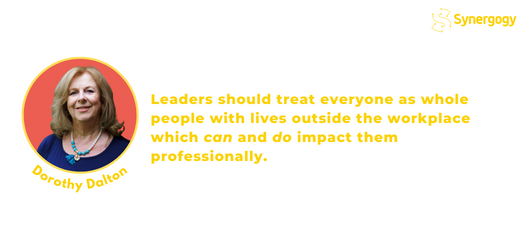
Organizations can cultivate a thriving workplace by implementing measures that nurture respect, open communication, and professional growth among team members. Initiating policies that endorse respect and healthy dialogue can be the cornerstone of fostering a harmonious work environment. Moreover, empowering employees to express their perspectives, apprehensions, and experiences can result in increased collaboration and a sense of belonging. Lastly, extending professional development possibilities, particularly to underrepresented groups, will ensure skill enhancement and career progression within the organization, contributing to an inclusive and rewarding atmosphere. By taking these steps, an organization can create an environment where all employees feel valued, included, and engaged. This can lead to higher job satisfaction, increased productivity, and lower turnover rates.

By doing it. I know that sounds trite, and maybe over simplified, but we spend a lot of time in business hand-wringing and strategizing and trying to do something perfectly that we forget the natural learning that comes from *doing*. Be prepared to apologize, know it’ll get messy, and start somewhere.
If you don’t know where to start, we recommend to our clients to go system by system through their department and rate themselves against the UN protected classes. Pick a class you have no representation from and start doing some research. For example – if you have no one who is a practicing Muslim in your organization, find out what are the common complaints of Muslims in the workplace. What can your organization reasonably accommodate – prayer times, mats, headwear, food, fasting? If you throw a Christmas party, could you also throw an Eid party? Etc, etc.
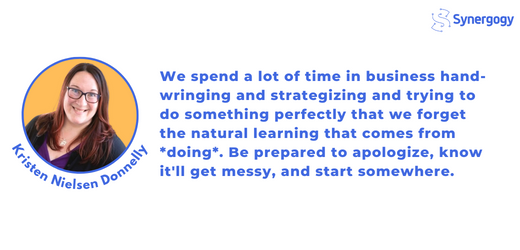
How can leaders foster a culture of respect and inclusion within their teams?
Several key practices are essential for leaders to cultivate a culture of respect and inclusion within their teams. Promoting open and transparent communication is crucial, as well as establishing channels that create a safe and welcoming environment for all team members to express their thoughts and ideas. This can be achieved through regular team meetings, one-on-one check-ins to discuss updates, concerns, or feedback, and the use of various tools to enhance daily communication, such as apps like WhatsApp or Slack.
However, these practices are only valuable when: A) leaders actively listen to their team members and consider their input when making decisions, and B) there are established expectations for the team and the organisation’s KPIs, as well as a code of conduct that outlines respectful and inclusive behavior.
Involving employees in decision-making processes, challenges, and achievements fosters a sense of belonging and lays the groundwork for employee accountability. This approach contributes to the team’s success, setbacks, and commitment to diversity, equity, and inclusion (DEI) values, creating a culture of mutual respect and trust. Strengthening team members’ sense of belonging can be achieved by investing in their growth within the organization through training and development, mentorship programs, and coaching. This investment in employee growth significantly enhances the team’s and organisation’s inclusion and equity by fostering diverse representation in leadership roles and providing relatable role models for other team members.
Leaders should lead by example and embody the behavior they wish to see within their team. This includes prioritizing diversity in hiring practices, seeking out a diverse range of perspectives when making decisions, remaining open to feedback and criticism, and “walking the talk.”
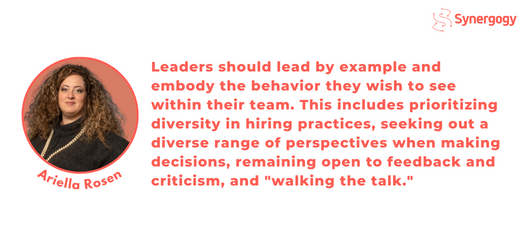
Start with getting to know your employees. As a people leader, sit down with your employees, via Microsoft Teams or face to face and get to know what’s important to them. Learn what drives them and ask how you can better support them. A key is to move quickly on that information and put that support into action. This will help build trust and help each employee feel the value that they bring to your company. This is not a one-time action; it is important to follow up and ensure they feel the support they need to be successful daily.
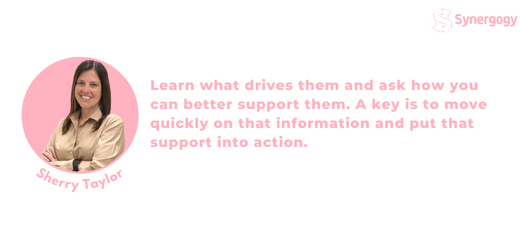
My first and best tip is education. No one person is responsible for educating anyone else on their culture, but should be invited to share about themselves when it is safe. From a leadership perspective, this means asking informed questions and modeling your staff to do the same.
Here are some basic things you can Google, for example, about the general feelings of police brutality in the United States: statistics for your area, stories shared on mass media and social media relaying personal experiences, organizational missions and research from organizations active in the work. Armed with that knowledge, when the opportunity arises, you can contribute to a conversation in good faith – showing that previous work has been done, but you’re open and willing to learn more.
Ask more questions, make less assumptions – and ask those questions to a variety of sources.


What are some best practices for addressing and preventing workplace discrimination and harassment?
Since the onset of the pandemic organizations have witnessed an overall increase in Ethics reports of harassment (including sexual harassment), incidents of violence and other inappropriate behaviors. To marshal this trend and provide safe and inclusive workplaces, organisations can respond with a framework of best practices aimed to impact short-medium-long term sustainable measures.
• Create a Compliance, Response and Escalation team comprising of leaders from Human Resources (HR), Labor & Employment Law (L&E Law) and Ethics & Compliance Office (ECO) to act as vanguards to advocate and lead this purpose, and sponsored by governance leadership (CEO, COO and CHRO)
• Reiterate global policies related to anti-discrimination, anti-harassment and anti-violence through firm-wide communications and Code of conduct training and awareness.
• Organise listening circles with various layers of the organisation, upholding safe spaces for employees to voice their concerns and support the organization in wider efforts. Reinforce ‘’we all have a part to play to provide a safe and inclusion workplace’’ call to action.
• Align and adhere to United Nations Ethics and compliance week; highlighting internal organisational policies with awareness dialogues and strong leadership narrative to reinforce the organization’s stance towards anti-discrimination and workplace respects
• A longer-term plan to ensure policy awareness and conduct more comprehensive training throughout the entire organization, led by leaders to have their voice and stance to elevate workplace respect and dignity at work.
Organisations face a culmination of systemic practices and cultural norms as implications to providing safe and inclusive workplace environments. Researched by Forbes (2021), employees are looking for visible and tangible actions where leaders take an intentional stance to building an inclusive culture where all differences matter, and also enhance facets of psychological safety in the workplace.
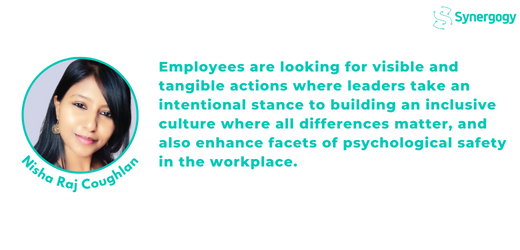
How can an organisation promote diversity and inclusion within its hiring processes?
The biggest barrier to lack of diversity and inclusion in hiring processes is unconscious bias which is reflected in every stage of the hiring process from intake interviews with the hiring manager, to sourcing to the screening and interviewing process.
1. Understand what diversity and inclusion mean to your organization which should reflect the organization’s values, mission, and goals.
2. Know your numbers. Which elements of diversity do you want to tackle first?
3. Train everyone in the recruitment process on the impact of unconscious bias including hiring managers.
4. Review and revise job descriptions to use inclusive language making sure that the key elements are not exaggerated ( years’ experience and education being the most common.)
5. Have a transparent salary policy with no gender pay gap. Include flex and other benefits in the job posting.
6. Source candidates from target groups by building critical relationships in these new areas and being open to applications from candidates from diverse backgrounds.
Use blind resume screening: take out key fields which are potentially bias traps (age, gender, address) and pay attention to the common biases such as education, employment, and career gap bias.
7. Use diverse interview panels that reflect the diversity of the candidates being interviewed.
8. Use structured interviews making sure that all candidates are treated in exactly the same way. Leave ample time for candidates to ask questions so they are able to express their uniqueness. Have a half-way point to check and review amongst panelists to check that all candidates are being evaluated equally.

Take the time to speak to your company culture. This is a great time to share information about your employee resource groups and how they have made an impact on the company as a whole. Share what these groups do and share how they have added value from your own personal perspective.

What role do employee resource groups (ERGs) play in creating a sense of belongingness within an organisation?
Employee resource groups (ERGs) can play a crucial role in creating a sense of belonging within an organization. ERGs are voluntary groups of employees who come together based on shared characteristics or life experiences, such as race, ethnicity, gender, sexual orientation, age, or disability.
Here are a few ways that ERGs can help create a sense of belonging:
Providing a support system: ERGs can provide a safe and supportive space for employees to connect with others who share their experiences and identities. This can be especially valuable for employees who may feel isolated or marginalized within the broader workplace.
Promoting diversity and inclusion: ERGs can help raise awareness about issues related to diversity and inclusion within the organization. By educating others and advocating for change, ERGs can help create a more inclusive and welcoming workplace.
Strengthening employee engagement: ERGs can help strengthen employee engagement by providing opportunities for employees to connect with others, feel valued and supported, and take pride in the organization’s commitment to diversity and inclusion.
Overall, ERGs can play a valuable role in promoting a culture of inclusivity and belonging within an organization. By providing a sense of community, promoting diversity and inclusion, offering professional development opportunities, and strengthening employee engagement, ERGs can help create a more positive and supportive workplace for all employees.

Employee resource groups help provide a voice for every employee. These groups have meetings or events where internal or external speakers can share their stories and provide a forum for open conversation. Many of these groups give opportunities for mentorship with individuals that could work in other departments, which helps build relationships and gives that employee more resources.


How can an organisation promote cross-cultural communication and understanding among its employees?
There are numerous practices that organisations can adopt to enhance cross-cultural communication and understanding among employees. While individual practices can be effective, only a comprehensive strategy will yield sustainable results.
Establishing a foundation of trust and a sense of belonging is crucial for promoting cross-cultural communication and understanding. One effective approach is ensuring multicultural representation in leadership roles at various levels within the organisation. Having diverse decision-makers contributes significantly to deeper understanding and more effective communication, promoting dialogue rather than monologue. Additionally, diverse role models become ambassadors for fostering cross-cultural connections throughout the organisation.
To enrich employees’ experiences, form and encourage cross-cultural teams that unite employees from various cultural backgrounds to collaborate on projects and tasks. This enables employees to learn from one another, appreciate different cultural perspectives, and develop stronger communication skills. Celebrate diversity by recognizing various cultural traditions, holidays, and events within the organisation and teams, fostering a sense of community and appreciation for various cultures. Develop programs that advance diversity and inclusion, such as affinity groups or employee resource groups, which offer spaces for employees to connect and share their experiences and perspectives.
Offer training and development programs for employees at all levels, including mentoring programs that pair employees from different cultural backgrounds to facilitate learning and the sharing of perspectives. Conduct training sessions on cultural awareness and sensitivity, covering topics such as different communication styles, norms, values across cultures, and the impact of cultural differences. When relevant, provide language training as well.
Effective communication requires clarity, openness, active listening, and genuine participation from all parties involved. Engage employees in discussions and decision-making processes, utilizing tools specifically designed for cross-cultural communication, such as translation software or cultural training videos. These resources help facilitate clear communication and understanding between employees from diverse cultural backgrounds.

Food! Food is incredibly emotional and personal and yet totally accessible. What if for every Friday staff meeting, someone brought their favorite childhood food? Or that Thanksgiving meal you usually have catered, turn it into a potluck of what Thanksgiving food is important to them.

How can an organisation measure the effectiveness of its diversity and inclusion initiatives?
An effective measurement strategy enables an organization to identify areas for improvement and develop targeted action plans to address any issues.
Begin by defining and establishing clear, measurable goals related to diversity and inclusion, such as increasing diversity of employees and leadership, enhancing employee engagement, and reducing turnover. Ensure that these goals are specific, achievable, and relevant to the organisation’s overall mission and KPIs. Gather employee perceptions of the organisation’s diversity and inclusion initiatives by conducting surveys and feedback sessions. These discussions can provide insights into the effectiveness of programs, policies, and practices, as well as suggestions for improvement.
Collect data on diversity, equity, and inclusion (DE&I) metrics, such as the number of employees from different demographics, turnover rates for those demographics, and employee engagement survey results. Analyze the data to identify trends and areas for improvement. This analysis can help pinpoint the root causes of any issues and inform the development of action plans to address them. Regularly monitor progress towards the goals set and track changes over time, which can help determine whether initiatives are having the desired impact and where additional action is needed.
For a more comprehensive understanding of areas for improvement, compare the organisation’s DE&I initiatives against industry standards and best practices. Adopting these practices will ensure that initiatives have the desired impact and foster continuous improvement in the organisation’s diversity and inclusion efforts.

How can employees be encouraged to speak up about instances of discrimination or harassment without fear of retaliation?
A good indication of an inclusive workplace is when employees talk about psychological security and say they feel able to speak up without fear of judgement or reprisals. Sadly, many don’t feel comfortable and between 66%-75% of inappropriate behaviour goes unreported.
These key steps will help:
1. Declare a zero-tolerance policy on discrimination and harassment clearly laying out the consequences for any breaches. Ensure that employees are required to sign the document as part of the onboarding process.
2. Provide training and resources: This is not a once and done activity but should be pursued on an ongoing basis. This includes providing informational resources including definitions of discrimination, bias, and harassment.
3. Set up team charters to establish pre-agreed boundaries and red lines and even signals for flagging up abuse. Some organisations use words like “ouch.” This way nothing gets brushed off as being “banter” or just a “joke.”
4. Encourage a call out culture with bystander interventions where the flagging up of breaches is part of everyday interaction.
5. Check the pulse of your teams: Encourage open communication by regularly checking in with employees and creating opportunities for feedback especially if you are senior. This can be done through anonymous surveys, suggestion boxes, or regular meetings with management.
6. Set up confidential and anonymous reporting protocols of any instances ensuring that all employees are aware of their rights and protections if they have negative experiences.
7. Take visible and prompt action: To have any credibility the organisation needs to take complaints seriously followed by a neutral investigation by an impartial third party. Hold the perpetrators accountable and don’t make exceptions for the “ toxic star.”
8. Provide support and resources: Give any targets of abuse and discrimination the opportunity for support, either informally within the organisation, via confidential counsellors or access to health care practitioners.

Here are five barriers preventing organisations from fostering safe and inclusive workplaces, where all can thrive –
• Tick box approach – resolving quotas to enhance diversity headcounts underpinning the importance to enhance measures of equity and inclusion. We need to propagate and bring awareness to the equation E+I=D
• Articulate the ‘why’ – the why and purpose has to resonate with decision makers, influencers and leaders. DEI and organisational culture thrives when it comes from within and channeled as a commitment and not compliance metric. Business and People leaders should create a compelling business case, social case and economic case to establish people imperatives as a strategic enabler to propel the organisation growth.
• Unclear organisation code of conduct and expectation setting – lack of enforcement of code of conduct and organisational values encourage workplace disrespect and discrimination. Clearly state and reinforce non-negotiables at the onset on employment with momentum of dialogue and awareness through the fiscal year leveraging existing mediums like townhalls, safety moments, leadership retreat, teaming sessions and quarterly leadership communications.
• Inequitable inclusion – imbalance in power equations, with little or no check-ins for employees with impartial entities like Employee relations, HR, mentors and mediators.
• Lack of awareness and reinforced education – we are all conditioned to process information and make decisions based on preexisting assumptions. Awareness programmes and dialogues should be mandated akin to technical and domain training, to mitigate facets of prejudice, unconscious and affinity bias and bring paradigms and intentional shifts to conscious inclusion.


In Conclusion,
Achieving a diverse and inclusive workplace culture is not just a moral imperative, but also a key driver of business success. Companies that prioritize diversity, equity, and inclusion (DE&I) benefit from a more engaged and motivated workforce, better innovation and problem-solving, and increased revenue and profitability. However, many organizations struggle to go beyond the basics of diversity and make meaningful progress towards creating a truly inclusive culture.
This is where DE&I experts come in. They have the knowledge, skills, and experience to help companies understand the complexities of workplace diversity and provide effective solutions for building a more inclusive culture. By adopting advanced DE&I strategies, companies can create a culture where employees of all backgrounds feel valued, respected, and empowered to contribute their unique perspectives and skills.
The strategies explored in this article include unconscious bias training, creating employee resource groups, fostering allyship, and adopting an intersectional approach to workplace inclusion. Unconscious bias training helps employees identify and address their biases, which can prevent them from making fair and objective decisions. Employee resource groups provide a platform for employees to connect and support each other based on their shared identities and experiences. Fostering allyship encourages employees to be active supporters of their colleagues from underrepresented groups. Adopting an intersectional approach to workplace inclusion acknowledges that people have multiple identities and experiences that shape their perspectives and experiences.
By implementing these advanced strategies, companies can create a more equitable, inclusive culture that empowers employees of all backgrounds to thrive and contribute to the organization’s success. However, it is essential to recognize that DE&I efforts require a long-term commitment and continuous improvement. Companies must regularly evaluate their progress, listen to feedback from their employees, and make necessary changes to ensure they are creating an inclusive workplace culture.
In conclusion, this article provides practical and actionable tips for organizations looking to take their DE&I efforts to the next level. By moving beyond traditional diversity programs and adopting advanced DE&I strategies, companies can create a culture that values and respects employees of all backgrounds, leading to better business outcomes and a more positive workplace experience for everyone.
Attend our FREE webinar!
